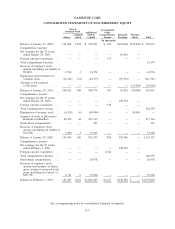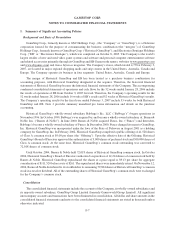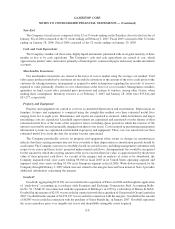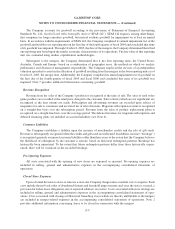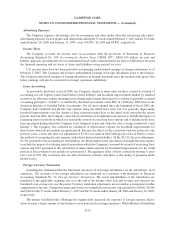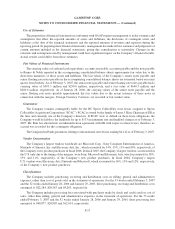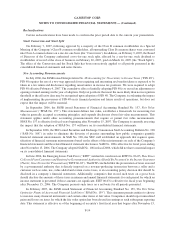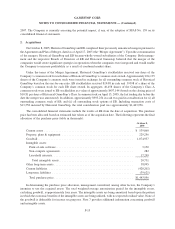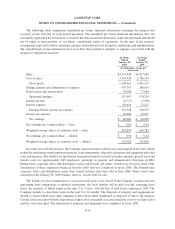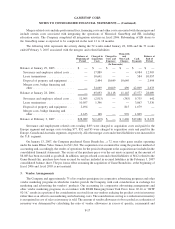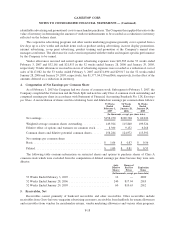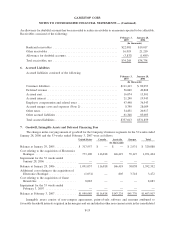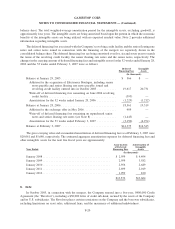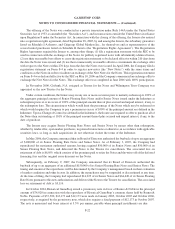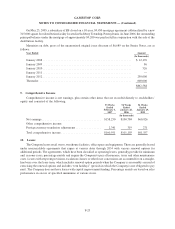GameStop 2006 Annual Report Download - page 81
Download and view the complete annual report
Please find page 81 of the 2006 GameStop annual report below. You can navigate through the pages in the report by either clicking on the pages listed below, or by using the keyword search tool below to find specific information within the annual report.Use of Estimates
The preparation of financial statements in conformity with GAAP requires management to make estimates and
assumptions that affect the reported amounts of assets and liabilities, the disclosure of contingent assets and
liabilities at the date of the financial statements and the reported amounts of revenues and expenses during the
reporting period. In preparing these financial statements, management has made its best estimates and judgments of
certain amounts included in the financial statements, giving due consideration to materiality. Changes in the
estimates and assumptions used by management could have significant impact on the Company’s financial results.
Actual results could differ from those estimates.
Fair Values of Financial Instruments
The carrying values of cash and cash equivalents, accounts receivable, accounts payable and the note payable
to Barnes & Noble reported in the accompanying consolidated balance sheets approximate fair value due to the
short-term maturities of these assets and liabilities. The fair values of the Company’s senior notes payable and
senior floating rate notes payable in the accompanying consolidated balance sheets are estimated based on recent
quotes from brokers. As of February 3, 2007, the senior notes payable and senior floating rate notes payable had a
carrying value of $593.3 million and $250.0 million, respectively, and a fair value of $640.5 million and
$260.6 million, respectively. As of January 28, 2006, the carrying values of the senior notes payable and the
senior floating rate notes payable approximated the fair values due to the recent issuance of these notes in
connection with the mergers. Foreign Currency Contracts are recorded at fair market value.
Guarantees
The Company remains contingently liable for the BC Sports Collectibles store leases assigned to Sports
Collectibles Acquisition Corporation (“SCAC”). SCAC is owned by the family of James J. Kim, Chairman of EB at
the time and currently one of the Company’s directors. If SCAC were to default on these lease obligations, the
Company would be liable to the landlords for up to $133 in minimum rent and landlord charges as of February 3,
2007. Mr. Kim has entered into an indemnification agreement with EB with respect to these leases, therefore no
accrual was recorded for this contingent obligation.
The Company had bank guarantees relating to international store leases totaling $4,142 as of February 3, 2007.
Vendor Concentration
The Company’s largest vendors worldwide are Microsoft Corp., Sony Computer Entertainment of America,
Nintendo of America, Inc. and Electronic Arts, Inc., which accounted for 14%, 13%, 11% and 10%, respectively, of
the Company’s new product purchases in fiscal 2006. In fiscal 2005, the Company’s largest vendors, as measured in
the U.S. only due to the timing of the mergers, were Sony, Microsoft and Electronic Arts, which accounted for 18%,
13% and 11%, respectively, of the Company’s new product purchases. In fiscal 2004, Company’s largest
U.S. vendors were Electronic Arts, Nintendo and Microsoft, which accounted for 14%, 13% and 12%, respectively,
of the Company’s new product purchases.
Classifications
The Company includes purchasing, receiving and distribution costs in selling, general and administrative
expenses, rather than cost of goods sold, in the statement of operations. For the 53 weeks ended February 3, 2007
and the 52 weeks ended January 28, 2006 and January 29, 2005, these purchasing, receiving and distribution costs
amounted to $22,284, $20,583 and $9,203, respectively.
The Company includes processing fees associated with purchases made by check and credit cards in cost of
sales, rather than selling, general and administrative expenses, in the statement of operations. For the 53 weeks
ended February 3, 2007 and the 52 weeks ended January 28, 2006 and January 29, 2005, these processing fees
amounted to $40,877, $20,905 and $12,014, respectively.
F-13
GAMESTOP CORP.
NOTES TO CONSOLIDATED FINANCIAL STATEMENTS — (Continued)




